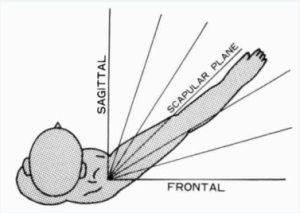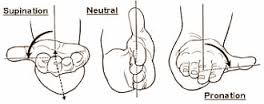Let me start off by saying this is a topic that really hits home with me. I was a swimmer for quite some time, unfortunately that eventually led to a lot of crappy shoulder aches and pains. From tendonitis, to impinged tendons I had it all! Luckily for me I was able to turn things around before anything really serious happened.
But…enough about me, time to help you!
The shoulder, specifically the front of the shoulder joint, is often the most unstable and “lax” portion of the shoulder. Exercises that stress this area are often going to result in your chronic or even acute injuries. The movements/exercises I’m referring to are ones that externally rotate the arm (thumbs turning away from your body), abduct the arm (movement you do in the typical lateral dumbbell raise), and horizontally abduct the arm (the down portion of a bench press where your arms move away from mid-line of your body).
Exercises that are going to put you in this position, are any typical overhead press or pull or lateral raise, an extreme example would be a Behind-The-Neck Lat Pull-Down or a Behind-The-Neck Overhead Barbell Press. Honestly, the only type of person I believe should ever consider doing these types of movements would be competitive bodybuilders. It’s in the nature of their sport to attempt to develop a muscle in all ranges of motion. For any other person or athlete, these are exercises you can seriously do without.
For a reference here are the behind the neck movements I was talking about…
Pull-down
Press
So first tip….
#1 – Don’t do these, keep the weight infront of you!
Now, there are a lot of people that believe pressing weight overhead shouldn’t be done and that it’s just to risky of a position for the shoulder. I believe all exercises have their risk so I’m going to tell you it’s perfectly fine. There are perhaps just better ways to do it.
Pressing overhead requires you to balance the weight as well as muscle it up. Having that weight above you forces your rotator cuff (muscles located on the back of the shoulder) to kick in and stabilize the joint, which is one of the primary functions of these muscles. In the end it ends up being a great workout for maintaining shoulder function and stability.
…and pressing something overhead is just a really great and empowering feeling!
I’m rambling on but this is leading to my second tip.
#2 – Work in the scapular plane!
The scapular plane is your best and safest position to do all of your lateral raises, pull-downs and overhead pressing. What it is referring to is the position of your upper arm when you do any of these movement. Here is a picture below http://www.sportsmedicineofatlanta.com/downloads/reference/AvoidingShoulderInjuryFromResistanceTraining.pdf
http://www.sportsmedicineofatlanta.com/downloads/reference/AvoidingShoulderInjuryFromResistanceTraining.pdf
..So whenever your doing something like a lateral dumbbell raise, instead of raising your arms directly out to the sides, your elbows are slightly more infront of you and not to the side. You can also use this arm positioning on your lat-pulldowns, pullups, overhead presses and lateral raises.
The scapular plane is referring to the position of your shoulder blades. They don’t sit flat on your rib cage, they are slightly angled. Working with your arms in this position is just mimicking that same angle but providing a safer platform for movement at the shoulder at the same time!
Here is another video example….. of me!
Finally my last tip… for now
#3 Work with a neutral grip whenever you can
Put your arms directly out infront of you with your palms facing the ceiling. You’re thumbs should be turned away from your body. In this position your arm is externally rotated (supinated). A neutral grip would be thumbs pointing up.
This is another safe position to work in. When your arms are internally rotated (pronated), so thumbs facing inward and palms facing the floor, there is a bony structure on your upper arm called the greater tuberosity that can rub up against and pinch the subacromial bursa and rotator cuff tendons.
Having a neutral grip when you exercise clears the greater tuberosity out of the way and creates more room for the shoulder to move freely. This is one of the reasons I prefer to do my overhead pressing with dumbbells instead of barbells, because barbells force you into a pronated grip and with dumbbells I can use any grip I like.
..so there you have it
My three tips for altering resistance exercises to keep your shoulders happy and healthy!
#1 – Don’t do anything behind the neck
#2 – Work in the scapular plane
#3 – Use a neutral grip whenever you can
Until next time, keep posting your questions and stay tuned for the next post to cover shoulder exercises for longevity and health!
